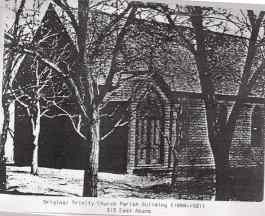 It was on a cold, rainy winter night that a number of devoted men and women met at the home of Mr. and Mrs. Wyard E. Gooch to organize an Episcopal Society. From the records of this meeting, we read: �A large number of ladies and gentleman met at the home of Mr. and Mrs. Wyard E. Gooch, Dec. 27, 1884 in response to a call to all those interested in the establishment of a Protestant Episcopal Society.� Mr. Gooch offered the following resolution:
It was on a cold, rainy winter night that a number of devoted men and women met at the home of Mr. and Mrs. Wyard E. Gooch to organize an Episcopal Society. From the records of this meeting, we read: �A large number of ladies and gentleman met at the home of Mr. and Mrs. Wyard E. Gooch, Dec. 27, 1884 in response to a call to all those interested in the establishment of a Protestant Episcopal Society.� Mr. Gooch offered the following resolution: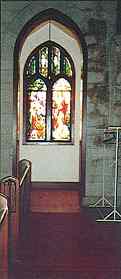 �We the undersigned, being interested in the formation of a Protestant Episcopal Society, do now offer our names, and agree to work and do all in our power to advance the interests of said Society as far as it lies within our power.� The resolution was signed by Mmes. C.M. Chappel, S. Wells, frank Beall, M.S. Hasie, W.E. Gooch, H.H. Perry, R.E. Grubbs, Mlles. Mollie Christian, Linda Christian, S.E. Groscup, Nellie Hasie, Eva Hasie, Mamie Steinman, Marcia Beal, Nellie Nash; Drs .A .J. Chappel, M. B. Vawter, and G. I. Hart; and Messrs. Charles Chappel, Frank Beall, Lute Coombs, W. E. Gooch, Frank Groscup, and R. E. Grubbs.
�We the undersigned, being interested in the formation of a Protestant Episcopal Society, do now offer our names, and agree to work and do all in our power to advance the interests of said Society as far as it lies within our power.� The resolution was signed by Mmes. C.M. Chappel, S. Wells, frank Beall, M.S. Hasie, W.E. Gooch, H.H. Perry, R.E. Grubbs, Mlles. Mollie Christian, Linda Christian, S.E. Groscup, Nellie Hasie, Eva Hasie, Mamie Steinman, Marcia Beal, Nellie Nash; Drs .A .J. Chappel, M. B. Vawter, and G. I. Hart; and Messrs. Charles Chappel, Frank Beall, Lute Coombs, W. E. Gooch, Frank Groscup, and R. E. Grubbs.That same evening a Ladies Society was organized with Mrs. Chappel named as president. Plans were made for the ladies to receive New Years calls on the afternoon of Jan. 1, 1885, and to serve an oyster supper in the evening at twenty-five cents per plate. The reception and supper were to be held in the K. P. Block, later referred to as the �Whittle Block.� The Society also set an invitation fee of twenty-five cents with monthly dues at 20 cents.
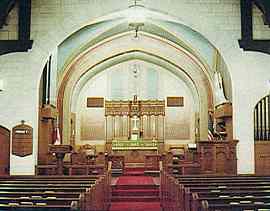 The Society soon made arrangements with the Rev. Mr. McKay of Emporia to conduct an Episcopal service in Hiland Hall, now the Burford building. This service was held on the first Sunday after Easter, April 12, 1885, and immediately afterwards a Sunday School was started with Mr. Gooch as superintendent.
The Society soon made arrangements with the Rev. Mr. McKay of Emporia to conduct an Episcopal service in Hiland Hall, now the Burford building. This service was held on the first Sunday after Easter, April 12, 1885, and immediately afterwards a Sunday School was started with Mr. Gooch as superintendent.The Right Reverend Thomas Vail, the first Bishop of Kansas, visited Arkansas City on Oct. 21, 1885, holding a service in the First Presbyterian Church. During the balance of 1885 and all of 1886, services were conducted by Laymen, Mr. Gooch and Dr. Chappel handling most of them. Occasionally, a visiting priest in the city would handle the service, thereby making possible the service of Holy Communion.
The first dance ever given by a Church Organization in Arkansas City was sponsored by the �Young Peoples Coterie� on Nov, 17, 1885 and was held in the Bishop Building on N. Summit St. Self denial offering of the members of the Society, supplemented with the proceeds from suppers, fairs, and parties, resulted in a treasury of several hundred dollars. Inspired by Bishop Vail�s Diocesan Convention address in December of 1886, which included the comment, �The people of Arkansas City are now quite in earnest for a revival of our services, I feel quite hopeful in the matter,� plans begin to be formulated for the organization of a parish.
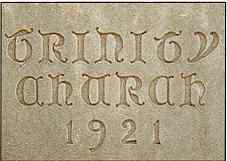 On July 13, 1887, the Right Reverend Elisha Thomas, newly elected Bishop Coadjuter of Kansas, visited Arkansas City, baptizing one adult and confirming 13 persons who had been instructed in the faith by Mr. Gooch. On July 19, Bishop Thomas returned to Arkansas City, and Trinity Church Parish was organized. Mr. Gooch and Mr. Herman O. Meigs were appointed as the first wardens. The Rev. W. W. Ayres of Wickford, R.I., was called as rector of the new parish at an annual salary of $1,200. with rectory supplied. Fr. Ayers held his first service on Oct. 1, 1887, and Trinty Church Parish was officially admitted as a parish in communion with the Diocese of Kansas in the Diocesan Convention meeting in Topeka in December, 1887.
On July 13, 1887, the Right Reverend Elisha Thomas, newly elected Bishop Coadjuter of Kansas, visited Arkansas City, baptizing one adult and confirming 13 persons who had been instructed in the faith by Mr. Gooch. On July 19, Bishop Thomas returned to Arkansas City, and Trinity Church Parish was organized. Mr. Gooch and Mr. Herman O. Meigs were appointed as the first wardens. The Rev. W. W. Ayres of Wickford, R.I., was called as rector of the new parish at an annual salary of $1,200. with rectory supplied. Fr. Ayers held his first service on Oct. 1, 1887, and Trinty Church Parish was officially admitted as a parish in communion with the Diocese of Kansas in the Diocesan Convention meeting in Topeka in December, 1887.With the population of Arkansas City at 6,000, 55 families had identified with the Church which resulted in a 47 member Church School and 40 communicants. Hopes and dreams ran high, and one of the pictures in the minds of these good people was a stone church building to cost about $10,000. The building was finally constructed�of wood, not stone.
 But as Bishop Thomas said at his first visit to the new church building on June 3, 1888, �I commend to the Diocese as a model of good taste and cheapness this church. It seats 200 and cost $1,300.� With a rectory under construction, this small parish soon had to begin payments on what must have been a staggering debt to them--$3,500.
But as Bishop Thomas said at his first visit to the new church building on June 3, 1888, �I commend to the Diocese as a model of good taste and cheapness this church. It seats 200 and cost $1,300.� With a rectory under construction, this small parish soon had to begin payments on what must have been a staggering debt to them--$3,500.The Rev. D. W. Howard served as the second rector of Trinity, followed in three years by the Rev. S. J. Morgan. These were exciting times, and such things as parish records often held a low priority. As Fr. Morgan reported, �I cannot find last year�s report. Owing to the extraordinary excitement here consequent upon the opening of the strip, it is impossible to get a satisfactory report from the Treasurer.�
But the parish debt was paid off and consecration of the buildings was requested from the Bishop in 1894. Then came a severe economic depression, and if that was not bad enough, we read in the records of the time, �After a few months� time, the secretary of the institution absconded with the funds, and is now sojourning in South America.� Bishop Thomas came right to the point: �This Parish has suffered greatly from removals and failure of business. It needs sympathy and encouragement: But the Church was not to be denied. Following Bishop Thomas� death in 1895, his successor, Bishop Millspaugh, consecrated the building to the service and worship of Almighty God on November 24, 1896.
A series of Rectors followed the Rev. Mr. Morgan until finally, in 1907, the Rev. Arthur V. Francis accepted the call of the Vestry to come to Trinity. Much of the credit for keeping the congregation together during those intervening years was due to devoted laymen. In 1902, Mr. A. J. Hunt was elected Senior Warden, and was a vital force in the parish until his death in 1918. Mr. E. Kirkpatrick, Warden, and Mr. O. E. Unsell, Church School superintendent made tremendous contributions to the life of the parish, as did Mrs. Joseph Tighe, Church School superintendent and Mrs. F. W. Doane, president of the Daughters of the King. Whenever there was a task to be done, there were those who were always ready and willing to serve. On one occasion when the Parish was without a rector, a woman of the Church administered the Sacrament of Holy Baptism to a dying baby.
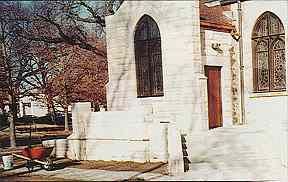 The year 1916 was a memorable one for Trinity. Messrs. Hunt and Kirkpatrick were the Wardens, and Mr. Ralph Sowden was Secretary of the Vestry. Under their leadership, the Vestry called the Rev. Fredrick F. Busch to serve as Rector. At that time there were 106 communicants, property valued at $6,100 and an annual income to the parish of $1,889.11 Fr. Busch served Trinity until 1931 when he was called to be the Dean of the Cathedral at Garden City, Long Island. He endeared himself to Church members and community alike, and under his direction, the parish more than doubled in size and church property increased to $78,000.
The year 1916 was a memorable one for Trinity. Messrs. Hunt and Kirkpatrick were the Wardens, and Mr. Ralph Sowden was Secretary of the Vestry. Under their leadership, the Vestry called the Rev. Fredrick F. Busch to serve as Rector. At that time there were 106 communicants, property valued at $6,100 and an annual income to the parish of $1,889.11 Fr. Busch served Trinity until 1931 when he was called to be the Dean of the Cathedral at Garden City, Long Island. He endeared himself to Church members and community alike, and under his direction, the parish more than doubled in size and church property increased to $78,000.On Jan. 1, 1922, the corner stone for the present church building and parish house, located at the corner of North A and Walnut, was laid. Construction required nearly a year, and the first service in the new building was held on Dec. 14. In the words of Bishop Wise, �It was an unforgettable service. A Pullman car load of representatives from all over the country of the Miller�s Association was present, led by Mr. William C. Edgar, in an inspiring address, presented to the church a bronze bas relief of Mr. Hunt which hangs at the entrance doorway. It was fitting that the church building should be a memorial to Mr. Hunt, since it was National Millers� Association that made a gift of nearly $12,000 towards the construction cost.� Other memorials such as the pulpit presented by Mrs. Doane; the Altar, Reredos and Altar Rail in memory of Mr. Kirkpatrick, and many others too numerous to mention, still grace this beautiful church building.
In 1929 upon the death of Mr. John Ames, founder of The Kanotex Refining Company, who had served Trinity Parish in many different capacities since 1918, Messrs, Ralph Sowden and Harry Earlougher were elected Wardens. Mr. Foss Farrer took the place of the Church pension Fund of the Diocese and also a member of the Bishop Vail Foundation. Mr. John Peck, who in 1976 is serving Trinity as her Treasure, succeeded Mr. Farrer as Treasure of the Church Pension Fund. Early in 1932 the Rev. Oscar Wetklo was placed in charge of Trinity as locum tenes, remaining until Nov. 1934. Upon his resignation, the Rev. Carlton A. Clark, from Independence, was called as a Rector, serving in that capacity until 1947. This, too, was a fruitful ministry, and the church continued to grow in size and stature within the Diocese. By 1939 the entire indebtedness on church property and buildings was paid off, and the buildings were consecrated by Bishop Wise on June 18th. of that year.
As always, much of the credit for the ongoing work of the church, including the provision of extra funds applied to mortgages on the buildings, must be given to the women. Thus many a dinner was served in the Parish Hall, including the regular hosting of the Rotary Club for several years. The Rev. Sherman Newton followed as the ninth rector of Trinity, and was in turn followed by the Rev. Robert Cashman. As we come to consider more �modern� times, names appear among the Wardens and Vestry that are know to many. In 1953, Mr. John Ranney was Senior Warden, Mr. Noble Wing Junior Warden, while the Vestry was composed of Messrs. Robert Anderson, Tom Buzzi (ordained as a deacon Oct. 24, 1954) Kirke Dale, Tom Eustice, John Peck, W. P. Shea and Dr. Leon Lyon. Among the ladies were Mrs. L.D. Mitchell, President of the Women�s Auxiliary (now referred to as the Ladies of Trinity) and Mrs. O. A. Malcolm, President of the Women�s Auxiliary of the Southeast Convocation of the Diocese. The following year, such names as Mmes. Charles Hill, E. T. Lindsay, J. W. Curtis, and C. E. Kaesbach (officers of the Women�s Auxiliary) and Messrs. William Cunningham, Jack Lampe and A. James Sowden, newly elected Vestry members.
On May 15, 1955, Mr. Doyle E. White (now a District Judge for the State of Kansas) was ordained to the Diaconate. And �at long last,� so the history reads, �that new air conditioning equipment was installed, thanks to members of the Women�s Auxiliary.� In this same year, a campaign was started to raise funds for an Education Building, a much needed addition because of growing membership. The Rev. Andrew Berry followed as the eleventh Rector of Trinity in Oct., 1959. A year later saw the completion of the Education Building. The Rev. Robert Terrill was called and began as Rector on April 1, 1964. During his tenure, a new 14-rank McManis pipe organ was installed, replacing the original organ that had been the gift of Mrs. Hunt in memory of her husband. Mrs. Ernestine Parker, who became the organist at Trinity on Aug. 1, 1972, continued in this capacity and will celebrate her 50th. anniversary as organist in 1977.
Upon the resignation of Fr. Terrill in 1968 the Rev. Harry Firth became the new Rector. Very much interested in the Montessori Method of instruction for pre-school children, he conducted a teacher-training course in the Montessori Method and the Trinity Day School soon came into being. Dr. J. Ruf became the Chairman of the Board at trinity Day School, and although there were misgivings as to its ultimate success, it was not long before it wasn�t a concern, under the capable direction of Mrs. Robert Milner, head teacher.
Fr, Firth had been at Trinity for only two years when he received a call from All Saints Parish in Kansas City. Then Rev. Lawrence Pierson of St. James Church, Wichita, accepted the call fom the Vestry and became the 14th. Rector of Trinity on Sept. 1, 1970. In the nearly six years that Fr. Pierson has been Rector, Trinity Day School has grown and currently has an enrollment of 40 children. Dr. Ruf continues as Chairman of the Board and Mrs. Jim Wilkins a well-trained teacher in the Montessori Method, is functioning as head teacher with both a morning and afternoon session for students.
As of this writing, Messrs. Robert Fryer and James Wilkin are the Wardens, while the Vestry is composed of Mmes. Floyd Bogart, Alan Bryant, and Jay Richardson, and Messrs. Howard Finch, Joseph Fortier, Oakley Lawrence and Dr. Newton Smith. Mr. John Peck is Treasure and Mr. Robert Milner serves as Clerk of the Vestry, Mrs. Gene Lichliter is President of the Women of Trinity, Mrs. Mike Foust is Church School Superintendent, and Mrs. Kenneth Hill is Directress of the Altar Guild. Licensed Lay Readers are Messrs. Dave Daulton, Frank Divall, Oakley Lawrence, Gene Snyder and Rick Hatfield (Rick is a second-year student at Nashotah House, one of the 13 seminaries of the Episcopal Church, preparing for the Priesthood of the Church). It is becoming more and more apparent that something wonderful is happening at Trinity.
There can be no doubt, it is the work of the Holt Spirit, Church attendance through May of 1976 has increased 32 per cent over the same period of 1975, and the entire parish looks forward with confidence to the future, nourishing by means of the Sacraments and the Word of God that hope, faith and love which are the hallmarks of the People of God.
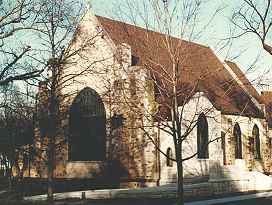 Trinity Episcopal Church...224 North "A" Street Arkansas City...PH# 620-442-1720,
founded 1882, present building built 1922. Built with Silverdale limestone in a modified Gothic
style, it's many stained glass windows are stunning works of art.
Trinity Episcopal Church...224 North "A" Street Arkansas City...PH# 620-442-1720,
founded 1882, present building built 1922. Built with Silverdale limestone in a modified Gothic
style, it's many stained glass windows are stunning works of art.